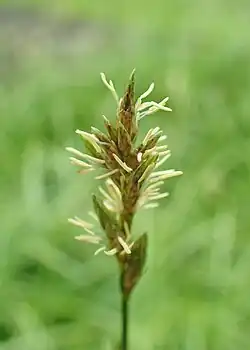Carex brizoides
| Carex brizoides | |
|---|---|

| |
| Inflorescence | |
| At the Botanical Garden Munich-Nymphenburg | |
| Scientific classification | |
| Kingdom: | Plantae |
| Clade: | Tracheophytes |
| Clade: | Angiosperms |
| Clade: | Monocots |
| Clade: | Commelinids |
| Order: | Poales |
| Family: | Cyperaceae |
| Genus: | Carex |
| Species: | C. brizoides
|
| Binomial name | |
| Carex brizoides | |
| Synonyms[2] | |
|
List
| |
Carex brizoides, the quaking sedge or quaking-grass sedge, is a species in the genus Carex, native to central and southern Europe.[2] Even where it is a native species, in disturbed woodlands it tends to behave invasively, forming a thick layer on the forest floor and reducing species diversity.[3][4]
-
A dense stand
References
- ^ Cent. Pl. I: 31 (1755)
- ^ a b "Carex brizoides L." Plants of the World Online. Board of Trustees of the Royal Botanic Gardens, Kew. 2017. Retrieved 16 December 2020.
- ^ Matějková, Ivona; Van Diggelen, Rudy; Prach, Karel (2003). "An attempt to restore a central European species-rich mountain grassland through grazing". Applied Vegetation Science. 6 (2): 161–168. Bibcode:2003AppVS...6..161M. doi:10.1111/j.1654-109X.2003.tb00576.x.
- ^ Chmura, Damian; Sierka, Edyta (2007). "The invasibility of deciduous forest communities after disturbance: A case study of Carex brizoides and Impatiens parviflora invasion". Forest Ecology and Management. 242 (2–3): 487–495. Bibcode:2007ForEM.242..487C. doi:10.1016/j.foreco.2007.01.083.